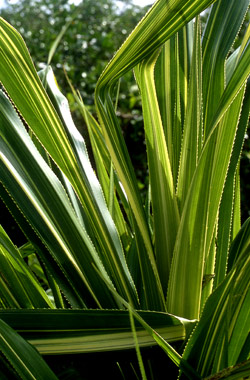 One of the most commonly used items in Fijian traditional culture is the “grass mat.” It is woven by hand from pandanus leaves. The long process of preparation includes scraping and boiling the leaves, and drying them in the sun. There are different mats used for different occasions, and some are made as gifts for formal occasions such as weddings. The pandanus leaves are gathered in large numbers and stored in bundles in the houses to dry out.
One of the most commonly used items in Fijian traditional culture is the “grass mat.” It is woven by hand from pandanus leaves. The long process of preparation includes scraping and boiling the leaves, and drying them in the sun. There are different mats used for different occasions, and some are made as gifts for formal occasions such as weddings. The pandanus leaves are gathered in large numbers and stored in bundles in the houses to dry out. 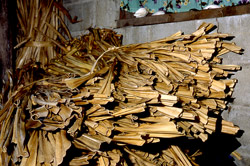 The patterns for utilitarian mats such as walls or floors are relatively simple because the mats are so large. But on smaller items the patterns are detailed and very artistic.The leaves are gathered and the spiny edges are stripped from the leaves which are then dried.
The patterns for utilitarian mats such as walls or floors are relatively simple because the mats are so large. But on smaller items the patterns are detailed and very artistic.The leaves are gathered and the spiny edges are stripped from the leaves which are then dried.  The dried leaves are split into long parallel strands but leaving one end whole so the strips are attached across the leaf. This makes it possible to handle a number of strands at the same time layering alternate strands in handfuls.
The dried leaves are split into long parallel strands but leaving one end whole so the strips are attached across the leaf. This makes it possible to handle a number of strands at the same time layering alternate strands in handfuls. 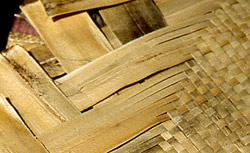 Once the strands are split they are lined up in a criss-cross pattern and the weaving begins. The pandanas leaves are naturally slightly different shades and the ladies make sure to arrange them in a pleasing pattern as they go.
Once the strands are split they are lined up in a criss-cross pattern and the weaving begins. The pandanas leaves are naturally slightly different shades and the ladies make sure to arrange them in a pleasing pattern as they go.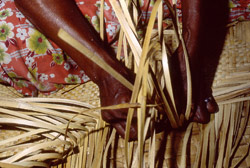
Once the leaves have been lined up they are separated alternately and held in one hand while the other hand sweeps through and pushes down every other strand.
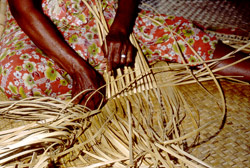
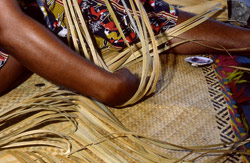
Now that the strands have all been separated they are carefully lined up opposite each other so that the leaves coming from a 90 degree angle can be interwoven one-by-one with each alternating strand.
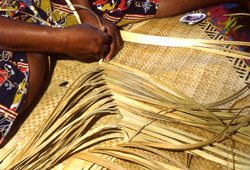
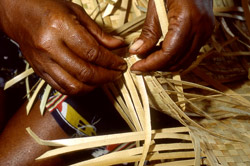
Nimble fingers pull the strands together in a rough pattern to begin with. Then the strands of leaves are tightly pulled into place and held there as the next one is interwoven. The closeness of the pattern seems much finer than the materials used to create it. This is the result of applying just the right amount of tension. The strands are doubled back to develop a thicker mat and more complex locking mechanism so the weave doesn’t spread. At each step the weaver needs to take care not to break the strand of dried leaf.
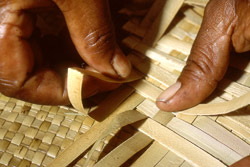 The mat is flipped over and back each time so the leaf is locked into place. Finally the mat edges are locked off with a special weave or in some cases with a heavy thread.
The mat is flipped over and back each time so the leaf is locked into place. Finally the mat edges are locked off with a special weave or in some cases with a heavy thread.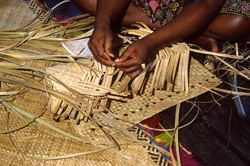
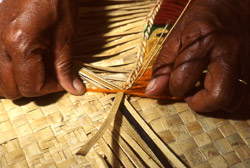
Most mats are bordered with highly decorative and brightly coloured wool. One well-known Fijian mat is the kuta, made by women in Vanua Levu, particularly Bua.

i like tobuy some mats
i would like to do it too
I’d vertune that this article has saved me more time than any other.
My email. stukino907gmail.com
i would to purchase some mats
If you want to buy mats pls let me know – send me an email on tuksnviti@yahoo.com
I like your post re the mats
I own a hand woven fijian mat and the edges are starting to curl up in some places. Do you know how to care for them and fix this problem?
It may be because you live in a really dry location. I don’t know the solution, but perhaps someone else does and can help by replying to your comment!
put something heavy on the edges that are starting to curl up and it should be back to normal in no time ! This happens to everybody that owns a mat.
Great advice!
Super inarimftove writing; keep it up.
Hi!
I would like to comment on the effort, sacrifies and timelessness patience these women does in trying to preserve their culture and values.
GOD BLESS THESE WOMEN
i would like to say something about the above comment, thank you very much for your blessing to her, VINAKA VAKA LEVU and may God bless you too…
I would like to learn if I were near to the, but i salute this ladies and thank you so much for loving your culture and keeping the traditional way of leaving. GOD BLESS YOU ALL
Wow…this was really useful for my Homework…!!!!!!!!thanks lot…!!!!!!!!!
Thanks for the information, this will be used for our class task. Vinaka Vakalevu
Would like to buy one if this is the traditional mat that is made with palm leaves.
I would like to buy one if this is the traditional mat made with palm tree
Hi I’m researching about different mats from Pasifika peoples and would like to know if there’s a traditional name for the grass mat in Fijian, and what it is used for. Will appreciate if anyone can help please. Thank you.
One well-known Fijian mat is the kuta, made by women in Vanua Levu, particularly Bua.
I want to know where did this mat making tradition originated from
need more information
need information of mat weaving including dates etc
Hi
I am from Australia. I am looking for coconut leave weave to use around a table , few tables. Can you help putting into contact from Sydney Arncliffe please.
Thank you
Nandini Fonseka
nandyfonseka@hotmail.com
This Infor Has Really Helped In Many Way Especiall to Me Becoz Iam Doin A Project On Fiji Art Of Weaving Even Though Its Just 20 Step It Has Greatly Contributed To My Research Work Also Has Enhaced My Understanding On My Weavivg Skills
its my project benefition you are uploading it…thanks all
do u have any way how it boosts our economy
can u please give some benefits of economy by mats
Advantages and disadvantages of mat weaving…?
benefits of pandanus please//
Hi
I like to buy one large mat please let me know
When was this website last updated?
im in New Zealand but i want to buy a kuta…please
do you have coco mat?
MORE information and more details
i want to know the the different types of mat there are in Fiji and their use
If your mat is curling I’d suggest you lay it outside in the sunshine. This will keep the mat soft and will also help keep it dry which will lengthen its lifespan.
Putting mats in the sun is good whether it’s curling or not.
Thanks a lot.It was really useful in my English project for Year 12.
thanx it really helped us in our year 12 english project..
thank you it really helped us in our english project
this helped me alot on my projectttt…if there are other additional informaton plizz in form meeee….vinaka viti
Thank you for the great effort in putting this piece of info online. I referred to it while trying to compile my project for ESD in my Post graduate studies.
Appreciate your effort to keep our culture alive!
Thanks a lot.It was really informative and useful in my English project for Year 12.
I would like to purchase a mat. Please let me know how, thanks so much, my email is kjensen777@gmail.com
The handicraft center in Suva will provide with a wide variety of ranges,patterns and sizes and they are great for your living room or your bedroom if you are looking for that Fijian homely feel
Just wonder where I can get such a nice mat, needs to be 2 x 2 m for underneath the dinner table. How much would this cost?
I am looking on behalf of a friend to purchase 2,500 to 3,000 square metres of pandanus mat for ceiling and walls in Tahiti. Can you point me in the right direction?
Hi there,
When exactly was this blog created?
The blog was prepared long after we were in Fiji. It is based on our experiences and the photos we took while we were there as guests of the University of Fiji, the Fisheries department, and to our great delight the local people who welcomed us to their islands and who offered protection by their knowledge of the ocean.
What can you do about a mat that has gotten moldy? 🙁
I just wash it with clean water in the moldy spots and dry it in the sun.
I just wash the moldy parts in clean water to remove the actual mold and then dry it rally well in the sun.
Surprising villagers with a fingerprint lock
Excellent post. I was checking continuously this blog and I’m inspired!
Extremely helpful info particularly the
remaining section 🙂 I deal with such information much.
I was seeking this certain info for a long time.
Thank you and best of luck.
Hello, I believe your website could be having browser compatibility issues.
Whenever I take a look at your web site in Safari, it looks fine
however, if opening in IE, it has some overlapping issues.
I merely wanted to give you a quick heads up! Other than that, great site!